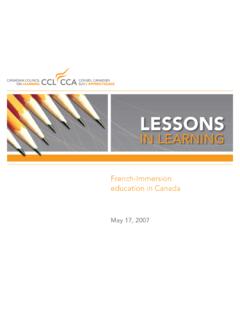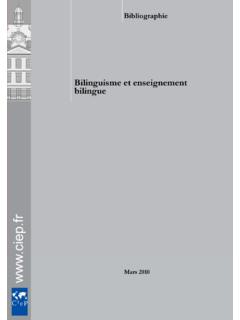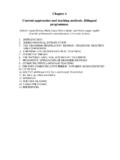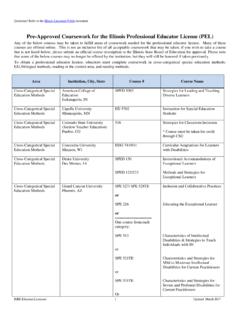Transcription of THE ABC’S OF ENGLISH IMMERSION A TEACHERS’ …
1 THE ABC SOF ENGLISH IMMERSION A TEACHERS GUIDECENTER FOR EQUAL OPPORTUNITYC enter for Equal Opportunity815 15th Street, 928 Washington,DC 20005 Phone (202) 639-0803 Fax (202) ABC SOF ENGLISH IMMERSION A TEACHERS GUIDEL inda ChavezPresidentCenter for Equal Opportunity Copyright 2000 Center for Equal OpportunityThe Center for Equal Opportunity was started in 1995 as a non-profit,tax-exempt,501(c)(3) is a non-partisan research institution studying the issues of race,ethnicity,and FOR EQUAL OPPORTUNITY3 CONTENTSINTRODUCTION4By Linda ChavezWHY ENGLISH IMMERSION ?5Is One Year Enough? / Page 6 Can ENGLISH Learners Attain Proficiency in One-Year IMMERSION Programs?
2 By Christine Works? What the Research Says / Page 9By Russell GerstenNUTS AND BOLTS11 ENGLISH IMMERSION for All Grades / Page 12 The Bethlehem,Pa., ENGLISH Acquisition ProgramBy Ann GoldbergTeaching Juan and Maria To Read / Page 16 Reading Instruction Techniques for ENGLISH Learners in Primary GradesBy Janet Siano Teaching ENGLISH to High School Students / Page 20By Richard Design and Implementation of an ENGLISH IMMERSION Program / Page 24By Kevin ClarkBibliography of Successful Reading Texts / Page 31 Recommended Materials for Scripted ENGLISH ImmersionBy Douglas Lasken THE LAW35It Works,But Is It Legal? / Page 36 What You Should Know about ENGLISH IMMERSION Programs and the LawByJim LittlejohnState Requirements for Educating ENGLISH -Learners / Page 41 ByAnita Garcia and Cynthia MorganAUTHORS44 INTRODUCTIONBy Linda ChavezThe education of ENGLISH -learners has beena concern of mine since my days as the edi-tor of American Educator magazine at theAmerican Federation of Teachers,a con-cern I shared with the late AFT President,Al there has always been a variety ofprograms designed to help ENGLISH -learners enter themainstream,bilingual education has been the pre-ferred this.
3 As early as the late 1970s concernsbegan to emerge over the lack of solid results for concerns were only intensified when myown son was nearly placed in one of these programssimply because of his Spanish teacherswrongly assumed that he needed help with his ENGLISH ,when in fact he speaks virtually no Spanish or any lan-guage other than ,parents complaints against bilingual pro-grams grew stronger as time went on:A poll conductedby the of Education in the1980sshowed little support for the program among immi-grant was little wonder,considering thatchildren in many of these programs spend 80 percent oftheir school day listening to their teachers speak lan-guages other than were right to ask, How are students supposed to learn ENGLISH if theyhardly ever hear it spoken,much less speak it?
4 It is unfortunate that bilingual education now bearslittle resemblance to the program begun 30 years ago,which was supposed to help Hispanic children learn tospeak,read,and write in ENGLISH as quickly and effec-tively as ,bilingual education deliberate-ly delays children from learning ENGLISH on the mistak-en assumption that kids need to receive five to sevenyears of formal classroom instruction in their native lan-guage before they can learn research doesnot support these on going debate over how best to educa t eEnglish-learners finally came to a head in 1998 whenCalifornia voters approved Proposition initia-tive replaced more than 20 years of state-mandatedbilingual education with what was considered a newapproach structured ENGLISH edu-cators in California complained bitterly that thisapproach was a
5 New, evil creation of the initiative ssponsor:a return to the bad old days of sink-or-swim, where students had to learn ENGLISH on their own andwere allowed to fail if they didn the critics ignored is that an ENGLISH immer-sion program specifically designed to meet the needs ofEnglish-learners is really not fact, IMMERSION ishow the vast majority of non-Spanish-speaking LEPstudents are educated,with great is onlyHispanic students who have been forced to participatein bilingual programs,generally to their this fact which led voters to replace the program the two years since this change was made inCalifornia schools.
6 The test scores for ENGLISH -learnershave increased dramatically. And the districts thataggressively implemented the ENGLISH IMMERSION pro-gram have consistently shown higher rates of improve-ment than the districts that maintained large numbersof their students in bilingual programs through theparental waiver success,which has received a great deal ofnational media attention,has led to a clear call forre f o rm .S chool distri c t s f rom New Yo rk City toHouston to Chicago and elsewhere are reevaluatingtheir programs for ENGLISH -learners and focusing onteaching more ENGLISH across thecountry,eager to replicate the success in California,areseeking information on structured ENGLISH Center for Equal Opportunity is proud to offerThe ABC s ofEnglish IMMERSION .
7 A Teachers it,we attempt to answer the most frequently asked ques-tions about teaching,designing,and evaluating anEnglish IMMERSION classroom and the research under-pinnings in favor of ENGLISH the helpof this guide ,teachers,administrators,and policymakerswill reach a better understanding of what structuredEnglish IMMERSION is all about,and the special difficul-ties that affect ENGLISH -learners at different grade levels,especially older ABC S OF ENGLISH IMMERSION : A TEACHERS GUIDE4 WHY ENGLISHIMMERSION?Is One Ye a rE n o u g h ?Can ENGLISH Learners AttainProficiency in One-YearImmersion Programs?By Christine , long should limited- ENGLISH -profi-cient (LEP) students be in a shelteredEnglish IMMERSION classroom,or forthat matter any language acquisitionprogram?
8 This is the most commonquestion asked by teachers,policymakers and the pub-l i c .U n f o rt u n a t e ly the answer provided by som eresearchers is to another question entirely:How longdoes it take the average LEP student to attain the aver-age ENGLISH language achievement of fluent Englishspeakers or a test publisher s criterion for ENGLISH profi-ciency? Proponents of this second question,however,aresimply wrong in believing that knowing how long ittakes an LEP child to achieve parity with nativeEnglish speakers,or to be classified proficient on anEnglish proficiency test,tells us how long they needspecial education services or how long they should be ina sheltered IMMERSION researchers jump to the conclusion that thenumber of years it takes LEP students to reach the aver-age for native ENGLISH speakers or the publisher s crite-rion for ENGLISH proficiency is the number of years thesechildren need special education are tworeasons why this conclusion is ,theresearchers who have reached this conclusion (Hakuta,Butler,and Witt,2000)
9 Have not used a research designthat could determine ,parity with Englishspeakers on ENGLISH proficiency tests or standardizedachievement tests is a badly flawed standard for deter-mining fluency in of allnative Englishspeakerscannot achieve the average standardized testscore for native ENGLISH speakers,and almost as large apercentage cannot achieve the publisher s criterion forEnglish can be fluent in ENGLISH ,indeed they canknow no language other than ENGLISH ,and yet fail toachieve the publisher s criterion for ENGLISH language proficiency tests,whether they are admin-istered only to LEP students (and called ENGLISH profi-ciency tests) or to ENGLISH -speaking students (andcalled achievement tests)
10 ,are norm-referenced on flu-ent ENGLISH speakers and are tests of the ability to speakand understand a language andtests of academic abilityin that publishers select a score on theEnglish pro f i c i e n cy tests that they claim denoteswhether a student is a fluent ENGLISH speaker,but in factthere are ENGLISH monolingual students who will scorebelow whatever score is selected unless it is the publishers select a score that can only beachieved by about 60 percent to 70 percent of theEnglish monolingual test scores only tell us who knows more and whoknows fewer answers to the items on the are deliberately selected to produce a normalcurve among ENGLISH -speaking students,and the testscores are highly correlated with socioeconomic students who score low in ENGLISH often scorelow in their native tongue because the tests also meas-ure academic ability,not just fluency.







